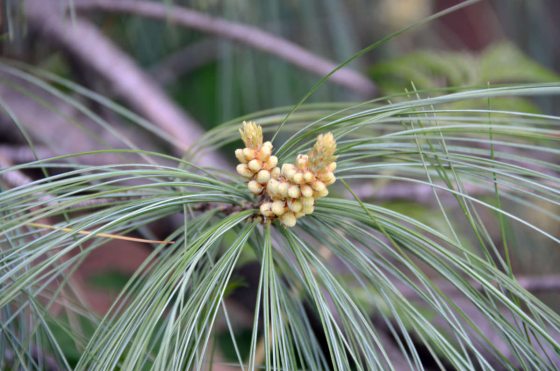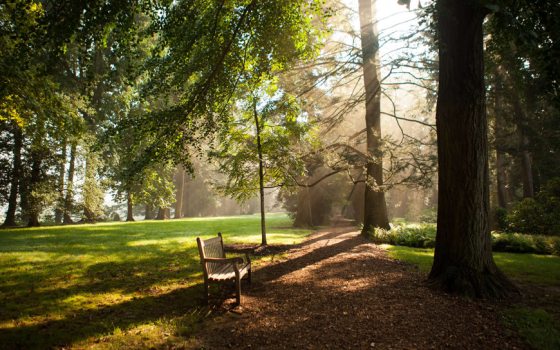Trees are an exceptionally important part of Longwood Gardens’ heritage and our future … they are nothing less than the backbone of our Gardens. Many of our trees, particularly those in Peirce’s Park—a historic collection of trees started in the 1800s—have been here long before us. In fact, our founder Pierre S. du Pont purchased the property in 1906 to save the historic trees planted in Peirce’s Park from being cut for lumber. A century later, we dedicate ourselves to the health and preservation of the trees not only in that historic allée, or walkway, but throughout our Gardens as a whole. Our task, however, is not an easy one … especially when we must, on a daily basis, consider how climate change affects our trees in the present and how it may shape our landscape—and our trees’ respective suitable habitats—in the years to come. It’s a challenge we undeniably face, but one we meet with steadfast tenacity to care for our trees in the most informed way.
Our dedication to our trees starts with our founder and is perhaps best described in a quote taken from the Caretaker’s Notebook of 1912: “No tree, dead or alive, is to be removed or trimmed, no matter whether located on the farm or in the woods, unless by special permission of the owner …. The preservation and care of trees is considered of first importance, as their injury is irreparable, while time and money (or both) will rectify most other mistakes.” Fast forward to 2008, we developed a detailed tree management plan that helps guide the care of Longwood’s historical trees. In 2013, we started including climate change modeling in our tree management program. By adding climate change modeling to our plan, we can help determine how certain tree species may grow in our region now and in the future, as well as help us make informed decisions when selecting trees for new plantings or replacements.
We’ve taken great care in researching climate change models for tree species, consulting with the United States Department of Agriculture’s Forest Service and Dr. Louis Iverson’s detailed Climate Change Atlas, which takes into account temperature, precipitation, land use, soil characteristics, elevation, and predicted atmospheric carbon dioxide levels to model suitable tree species habitat for the next hundred years. As the climate changes, suitable habitat might also change for certain tree species, resulting in greater, decreased, or even eliminated habitat for a given species, as well as creation of new habitat in areas of the country currently unsuitable for the species.

When considering our tree management efforts in the context of climate change modeling, we not only consider the future, but also the present. In the present, we must adapt and build the resilience of our current trees, taking away stresses that may lead to the detriment of our trees. One way that we’ve been helping our Peirce’s Park trees build resilience is by air spading the trees in Peirce’s Park, as part of an improvement plan led by Senior Horticulturist Pandora Young. The air spading process forces compressed air into the ground and decompacts the soil ... it’s almost as if we’re massaging the tree’s surrounding soil; you can feel the soil release as you’re spading. The air spading process creates deep, 4-inch-wide holes in the soil, which we then fill with organic matter, such as compost. The increased air and nutrients resulting from this process are beneficial to root growth and the back-filled holes allow water to infiltrate the root zone more easily. We can help mitigate increased drought stress to plants caused by rising temperatures and changes in precipitation by finding ways to allow soil to absorb more moisture … so if climate change means more drought stress and greater heat, allowing the soil to absorb more moisture will help the trees in the long run.
In addition to air spading, we’ve been working to reduce soil compaction under each and every tree, and underplanting the majority of the trees, in the allée … a six-year venture that we just completed this year. Underplanting serves a number of purposes, including reducing foot traffic and mowing directly under the tree, thereby protecting the tree’s roots, which helps prevent the soil from being compacted. Underplantings essentially act like a living layer of mulch. While this is an effort we would have certainly undertaken without the consideration of climate change, global heating most definitely increases our motivation to do it.


When we look at the future in response to climate change predictions, we focus on future tree species selection, considering projected suitable habitats and climate change models. Keep in mind that climate change is not as simple as temperatures will get warmer. It also means that our climate may become wetter, with more intense storm events (and those underplantings in Peirce’s Park will help with future stormwater management, as the roots of the underplantings reduce soil erosion caused by intense storms). In addition, many regional pests and pathogens are expected to benefit from the resulting longer growing season, wetter conditions, and warmer temperatures, so we also work to increase our trees’ resilience against a forecasted increase in pests by fostering a healthy biome for beneficial insects and fungi. In woodland areas, as one example, we do not remove fallen wood, in order to provide growing medium for beneficial fungi and habitat for diverse fauna.
Trees in our collection that are considered perhaps the most vulnerable to climate change are our beeches, cherries, birches, and sugar maples, according to climate change vulnerability research presented by the Forest Service. Specific examples of these trees, and those common in the Philadelphia region, that could be most vulnerable to a climate change effect include Betula populifolia (gray birch), Fagus grandifolia (American beech), Pinus strobus (eastern white pine), and Prunus serotina (black cherry). In contrast, some species of oak and hickory trees would actually benefit from projected climate change in our region. In response, we are increasing plantings of climate change-adapted species such as these and planting more vulnerable species (such as some species of beech trees) only in locations where they are most likely to succeed and be under less stress.

It’s a reality that we must plan future plantings to reflect shifts in suitable habitat throughout Longwood’s overall canopy. A tree that is not in its ideal climate and thereby stressed will experience a shorter lifespan and will be more susceptible to pests and diseases, similar to a person’s weakened immune system when under stress. Following and evolving our tree management plan as time passes and considering the strategies other gardens are employing are both crucial in our work to mitigate effects of climate change and create a resilient tree collection.


